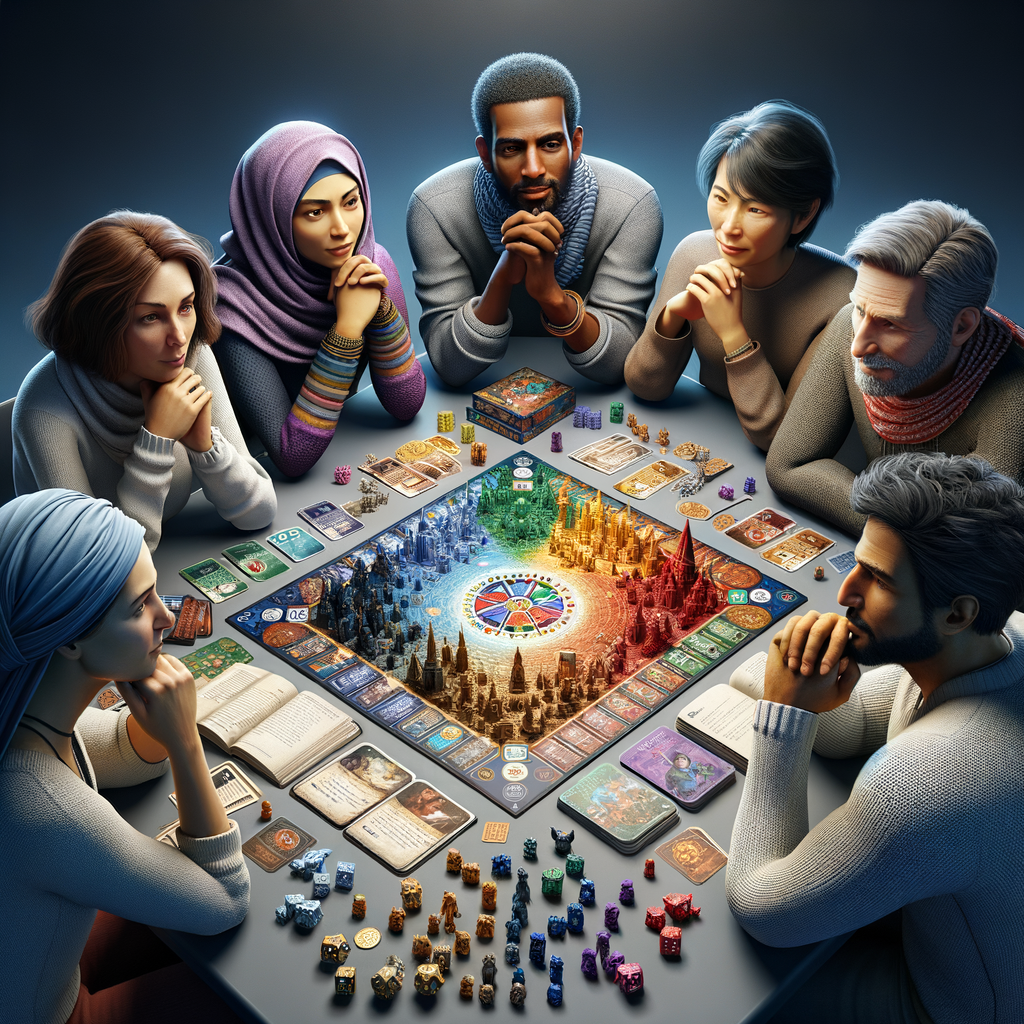Introduction to Storytelling in Board Games
Board games have long been a popular form of entertainment, bringing people together for friendly competition and shared experiences. But beyond the dice and game pieces, there’s a crucial element that often goes unnoticed – the story. Let’s delve into the fascinating world of storytelling in board games and discover why it’s so important.
- The Importance of Narrative in Games
Storytelling is not just for books or movies; it’s an integral part of many board games too. A compelling narrative can turn a simple game into an immersive experience, engaging players emotionally and mentally. According to a study by University of Rochester, games with strong narratives can enhance players’ problem-solving skills and creativity.
When a game has a story, it’s not just about winning or losing. It’s about embarking on a journey, overcoming challenges, and achieving a goal. The narrative gives context to the game’s mechanics and rules, making them more meaningful and enjoyable. It also encourages players to invest more time and effort into the game, enhancing their overall gaming experience.
- Overview of Story-Driven Board Games
Story-driven board games are those where the narrative plays a central role. These games often have detailed backstories, complex characters, and evolving plotlines. They can transport players to different worlds, from medieval kingdoms to futuristic galaxies.
One popular example is Pandemic, a cooperative game where players work together to stop the spread of deadly diseases across the globe. The game’s narrative heightens the sense of urgency and cooperation, making every decision crucial and every victory satisfying.
Another example is Betrayal at House on the Hill, a game that combines strategy, luck, and storytelling. In this game, players explore a haunted house, encountering different events and items that shape the game’s story. The narrative changes with each play, ensuring a unique experience every time.
In conclusion, storytelling is a powerful tool in board games, enhancing gameplay and enriching the player experience. So next time you play a board game, take a moment to appreciate the story behind it. You might find it adds a whole new dimension to your game night.
Understanding Board Game Storytelling
 Storytelling in board games is an art that enhances the gaming experience, making it more immersive and engaging. Let’s delve deeper into understanding this concept.
Storytelling in board games is an art that enhances the gaming experience, making it more immersive and engaging. Let’s delve deeper into understanding this concept.
Defining Board Game Narrative
Board game narrative, or storytelling, is a crucial aspect that can transform a simple game into an epic adventure. Let’s break it down.
What is board game storytelling?
Board game storytelling is the process of weaving a tale or narrative into the gameplay. It’s not just about rolling dice or moving pieces on a board. It’s about creating a world within the game, where players can immerse themselves and interact with the story. For example, in the board game Dungeons & Dragons, players are not just moving pieces around; they are adventurers exploring a fantasy world, battling monsters, and completing quests.
Role of narrative in board games
The narrative plays a significant role in board games. It provides context and meaning to the players’ actions, making the game more than just a series of mechanical actions. The narrative can influence the players’ decisions, add emotional depth, and increase player engagement. For instance, in the game Pandemic, players work together to stop the spread of diseases across the globe. The narrative of saving the world from a pandemic makes the game more engaging and meaningful.
In conclusion, understanding board game storytelling is about appreciating the narrative woven into the gameplay. It’s about experiencing a game as more than just a series of moves, but as a journey, an adventure, or a challenge to overcome.
Storytelling Techniques in Board Games
Storytelling in board games is an art that requires skill and creativity. It involves the use of various techniques to create a captivating narrative that engages players and enhances the gaming experience. Two of the most common techniques used in board game storytelling are the use of characters and settings, and creating narratives through game mechanics.
- Use of Characters and Settings
Characters and settings play a crucial role in board game storytelling. They provide the backdrop against which the game unfolds and help to set the tone and mood of the game. For instance, in the popular board game Monopoly, the characters are the various pieces that players choose to represent themselves, and the setting is the city with its various properties. The characters and settings in a board game can be as simple or as complex as the game designer chooses, but they must always serve to enhance the narrative and engage the players.
- Creating Narratives Through Game Mechanics
Game mechanics are the rules and procedures that guide the play of a game. They determine how players move, how they interact with each other and with the game world, and how they can achieve their goals. In board game storytelling, game mechanics can be used to create narratives. For example, in the board game Pandemic, the game mechanics involve players working together to stop the spread of diseases across the globe. This creates a narrative of cooperation and urgency that engages players and enhances the gaming experience.
In conclusion, storytelling in board games involves the use of characters and settings, and creating narratives through game mechanics. These techniques help to create a captivating narrative that engages players and enhances the gaming experience. As a board game designer, understanding and effectively using these techniques can greatly improve the quality of your games.
Importance of Narrative in Games
Understanding the importance of narrative in games is crucial for both players and game designers. A compelling story can transform a simple game into an immersive experience, captivating players and enhancing their engagement. Let’s delve into how narratives engage players and explore some examples of board games with strong narratives.
Engaging Players with Story
Storytelling in games is not just about adding a plot. It’s about creating a world that players can immerse themselves in, making the game more engaging and enjoyable.
How narrative enhances player engagement
A well-crafted narrative can make a game more engaging by giving players a reason to keep playing. Players become invested in the characters and the world, eager to see how the story unfolds. This emotional connection can make the game experience more satisfying and memorable. According to a Wikipedia article on video game narrative, games with strong narratives often have higher player retention rates.
Examples of board games with strong narratives
Several board games have successfully incorporated strong narratives into their gameplay. For instance, “Pandemic Legacy: Season 1” is a cooperative board game where players work together to prevent global outbreaks of diseases. The game unfolds over several sessions, with the story evolving based on the players’ actions. Another example is “Betrayal at House on the Hill,” a game where players explore a haunted house, with the narrative changing each time they play. These games demonstrate how a compelling narrative can enhance the gaming experience.
In conclusion, the narrative in games plays a significant role in engaging players. It provides a context for the gameplay, making the experience more immersive and enjoyable. Whether you’re a player looking for a more engaging game or a game designer aiming to create a memorable experience, understanding the importance of narrative in games is essential.
Role of Story in Game Design
Storytelling is a crucial aspect of game design. It’s not just about the mechanics of the game, but also about the narrative that drives it. Let’s delve into how narrative influences game design and examine a case study on board game narrative design.
- How narrative influences game design
The narrative or story of a game is what gives it context and meaning. It’s the backbone that supports the gameplay mechanics and makes the game more immersive. For instance, in a board game, the narrative might explain why players are competing against each other or what they’re trying to achieve. It can also influence the game’s rules, objectives, and even the design of the game pieces. The narrative can be a powerful tool for game designers, helping them to create a more engaging and memorable gaming experience.
- Case study: Board game narrative design
Let’s look at a popular board game, “Pandemic,” as an example of effective narrative design. In “Pandemic,” players work together to stop the spread of diseases across the globe. The narrative is not just a backdrop, but it directly influences the game’s mechanics. Players must collaborate and strategize, mirroring the real-world challenges of disease control. The narrative adds a sense of urgency and purpose, making the gameplay more engaging and meaningful. This case study highlights how a well-crafted narrative can enhance a game’s design and playability.
As we can see, the role of story in game design is significant. It’s not just about creating a fun game, but also about crafting a compelling narrative that draws players in and keeps them engaged. So, when designing a game, don’t overlook the power of a good story.
Crafting Stories in Games
Creating a captivating narrative in a game is an art that requires careful planning and execution. The story is the backbone of any game and can make or break the player’s experience. In this section, we will explore how to craft immersive game worlds and delve into some case studies of board games with immersive narratives.
Creating Immersive Game Worlds
Building a game world that is immersive and compelling is a complex task. It requires a deep understanding of the game’s theme, mechanics, and player expectations. Let’s break down the process.
Building a compelling game world
The first step in creating an immersive game world is to establish a strong theme. The theme should be engaging and resonate with the players. It should be integrated into every aspect of the game, from the mechanics to the artwork. The game world should also be consistent. Consistency in the game world helps to create a sense of realism and immersion. It’s also important to create a sense of progression and development within the game world. This gives players a sense of achievement and keeps them engaged.
Case study: Board games with immersive narratives
Let’s take a look at a case study of a board game with an immersive narrative. “Pandemic Legacy: Season 1” is a cooperative board game that has been praised for its immersive narrative. In the game, players work together to prevent the spread of diseases across the globe. The game’s narrative unfolds over multiple sessions, with the decisions made in one session affecting future sessions. This creates a sense of continuity and progression, making the game world feel alive and dynamic. The game’s success shows the power of a compelling narrative in creating an immersive game world. You can read more about the game on Wikipedia.
In conclusion, crafting an immersive game world requires a strong theme, consistency, and a sense of progression. By studying successful examples, we can learn how to create compelling narratives that engage players and enhance the gaming experience.
Developing Memorable Characters
One of the key elements in crafting engaging stories in board games is the development of memorable characters. These characters serve as the bridge between the players and the game world, allowing players to immerse themselves in the narrative. Let’s explore how to create characters that resonate with players and look at some examples of memorable characters in board games.
- Creating characters that resonate with players
Creating characters that resonate with players is a crucial aspect of board game storytelling. These characters should be relatable and have depth, allowing players to form a connection with them. They should have unique traits, strengths, and weaknesses that make them feel real and human. For instance, a character who is a brave knight might also struggle with fear of failure. This complexity makes the character more interesting and relatable to players.
Moreover, the character’s goals and motivations should align with the game’s objectives. This alignment helps players feel more invested in the game’s outcome. For example, if the game’s objective is to save a kingdom from a dragon, the character could be a knight motivated by a sense of duty and honor to protect his kingdom.
- Examples of memorable characters in board games
There are many examples of memorable characters in board games. Let’s look at a few:
1. Sherlock Holmes in “Sherlock Holmes Consulting Detective”: Sherlock Holmes is a character that players can easily recognize and relate to. His sharp wit and deductive skills make him a compelling character in this detective game.
2. The various characters in “Pandemic”: In this cooperative board game, each player takes on the role of a different character with unique abilities, such as the Scientist who can discover a cure faster, or the Operations Expert who can build research stations. These characters add depth to the game and make each playthrough unique.
3. The adventurers in “Betrayal at House on the Hill”: Each character in this game has their own backstory and unique abilities, adding to the game’s immersive storytelling. The characters’ diverse skills and personalities create a rich narrative experience for players.
In conclusion, developing memorable characters is an essential part of crafting engaging stories in board games. By creating characters that resonate with players and incorporating them into the game’s narrative, you can enhance the player’s immersion and enjoyment of the game.
Conclusion: Mastering Board Game Storytelling
As we wrap up our exploration of storytelling in board games, it’s clear that this aspect is not only crucial for enhancing the gaming experience but also for fostering creativity and strategic thinking. Let’s summarize the key takeaways and look ahead at the future of narratives in board games.
- Key takeaways in mastering the art of storytelling through board games
Firstly, understanding the mechanics of storytelling in board games is essential. The narrative should be engaging and immersive, drawing players into the game world. Secondly, the importance of narrative in games cannot be overstated. It adds depth and richness to the gameplay, making each game a unique experience. Lastly, crafting compelling stories in games requires creativity and a good understanding of the players’ perspectives. It’s about creating a world that players can connect with and feel a part of.
- The future of narrative in board games
The future of board game storytelling looks promising. With advancements in technology, we can expect more innovative ways of integrating narratives into games. Virtual reality and augmented reality, for instance, could take board game storytelling to a whole new level. Additionally, as the board game industry continues to grow, there will be more opportunities for diverse and inclusive narratives, reflecting the wide range of players worldwide.
In conclusion, mastering the art of storytelling in board games is a rewarding endeavor. It not only enhances the gaming experience but also contributes to the growth and evolution of the board game industry. So, whether you’re a game designer or a passionate player, understanding and appreciating the narrative aspect of board games can truly enrich your board gaming journey.



